The Power of Organized Scheduling in the Modern Workplace
In today’s hybrid and remote work culture, one of the biggest challenges organizations face is managing time effectively. With multiple meetings, shifting priorities, and growing teams, maintaining coordination can quickly become complex. The ability to organize meetings seamlessly and manage shared calendars efficiently is no longer optional, it’s essential for productivity.
BLOG
10/28/20252 min read


In today’s hybrid and remote work culture, one of the biggest challenges organizations face is managing time effectively. With multiple meetings, shifting priorities, and growing teams, maintaining coordination can quickly become complex. The ability to organize meetings seamlessly and manage shared calendars efficiently is no longer optional, it’s essential for productivity.
Whether your team is in a single office or spread across continents, successful collaboration begins with proper scheduling. A clear, structured process ensures that meetings add value rather than becoming a burden.
The Rise of Smarter Scheduling Practices
Meetings are the backbone of communication, but excessive or disorganized ones can derail progress. The shift toward structured scheduling came from a need to reduce wasted time and improve participation.
Many organizations now follow systematic processes for sending out meeting invites and keeping their calendars synchronized. For example, when teams need to organize large sessions or company-wide events, they often rely on mass calendar invite setups to notify everyone efficiently. Similarly, departments coordinating global meetings benefit from the ability to send mass meeting invites to ensure all participants receive the same details at once.
These practices simplify communication and help maintain consistency, especially in large organizations where miscommunication can lead to costly delays.
Managing Meetings Across Platforms
Different workplaces use different platforms for communication, with Microsoft 365 (O365) being one of the most common. It allows professionals to create bulk meeting invites in O365 and synchronize them with their team’s availability. Similarly, organizations that prefer Microsoft Outlook often use it to send mass meeting invite in Outlook, streamlining the scheduling process.
These methods go beyond simple convenience, they ensure accuracy. With hundreds of employees potentially involved, a single missed update or incorrect time slot can create widespread confusion. Structured calendar systems minimize these risks and keep everyone aligned.
The Importance of Clear Communication
A meeting invitation is more than a time slot, it's a message. It sets expectations for what will be discussed, who should attend, and what the desired outcomes are. When crafting invites, clarity is key:
Use concise subject lines that reflect the meeting’s purpose.
Share an agenda or short note about discussion points.
Set appropriate time zones for global participants.
When everyone understands the meeting’s intent, engagement improves, and outcomes become more measurable.
The Role of Calendar Organization
Keeping a well-maintained calendar might seem like a small task, but it has a major impact on productivity. A properly managed invite calendar helps teams visualize their week, identify free slots for deep work, and avoid scheduling overlaps.
A shared calendar system also promotes transparency. Team members can easily see when others are busy, reducing unnecessary back-and-forth messages and improving coordination.
Avoiding Meeting Overload
One of the biggest mistakes organizations make is over-scheduling. While meetings are essential, too many of them can reduce efficiency. To prevent overload:
Limit meetings to essential topics.
Combine similar sessions when possible.
Encourage asynchronous communication for minor updates.
An efficient schedule helps maintain energy and focus across the team, leading to better decision-making and innovation.
Balancing Structure and Flexibility
Great scheduling is a balance between structure and flexibility. While systems and calendar tools help with organization, leaders should still allow room for adjustments. Rescheduling, cancellations, or shifting priorities are all part of a dynamic work environment. The goal is to build processes that adapt smoothly to change.
Conclusion
Scheduling might sound simple, but it defines the rhythm of an organization. From project reviews to brainstorming sessions, well-planned meetings create structure, alignment, and focus. Whether it’s managing bulk calendar invite in Outlook setups or organizing mass meeting invites in O365, the foundation remains the same, effective communication and respect for everyone’s time.
A thoughtful scheduling culture doesn’t just keep your team organized, it keeps your business moving forward.
MassCalendar.in
Send Bulk & Mass Calendar Invites Instantly
CONTACT
Meetings
+44 (0) 203 916 5117
© 2025. All rights reserved.
Help?
